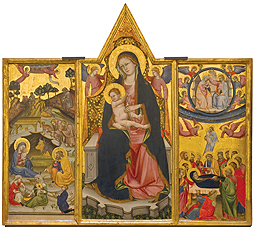 |

 |
 |
The Madonna and Child with Scenes from the Life of Christ and the Virgin (The Beffi Triptych), Master of the Beffi Triptych, about 1420–40, Museo Nazionale d'Abruzzo, L'Aquila, Italy. Courtesy of the Soprintendenza dell'Abruzzo e la Direzione Regionale dell'Abruzzo
|
 |
An important work from the National Museum of Abruzzo in the city of L'Aquila, The Beffi Triptych is on loan to the Getty Museum from the Italian government and on view in the Museum's North Pavilion gallery (N 201) at the Getty Center, and hangs amongst the Getty's paintings from the early to late 15th century.
Painted by an unknown artist, the triptych is representative of the late Gothic period in Abruzzo and embodies all the qualities of figurative painting from the region during the 15th century. Named after the nearby town of Beffi, where it once adorned the Church of Santa Maria del Ponte, the work depicts scenes from the life of the Virgin Mary, who appears in the central panel, enthroned with the Christ child beneath an elegantly brocaded canopy.
It has been suggested that the painter may have been a follower of the Sienese artist Taddeo di Bartolo (Italian, about 1362–1422), as works by the Master of the Beffi Triptych, like those of Bartolo, are distinctive for their lively narrative detail, highly expressive figures, and brilliant colors. In addition to panel paintings, this anonymous painter also illuminated manuscripts and created frescoes. Experts identify him as the artist who created the fresco in the vault and the walls of the presbytery of the Church of San Silvestro in L'Aquila in the early 1400s.
|

 |
 |
The interior of the Museo Nazionale d'Abruzzo following the 2009 earthquake
|
 |
 |
On April 6, 2009, the Abruzzo region in central Italy experienced a large earthquake in which more than three hundred people perished, fifteen hundred were injured, and sixty-five thousand were left homeless.
The earthquake also extensively damaged 25 percent of the region's historic buildings, including the Museo Nazionale d'Abruzzo in L'Aquila, which was condemned. The Beffi Triptych, one of the most important works from the museum, miraculously survived the disaster. Unlike many other works of art in the Museo Nazionale d'Abruzzo, the triptych has now been repaired after suffering only minimal damage in the earthquake.
The Italian government offered the altarpiece for display as a gesture of gratitude toward the United States—one of the first countries to assist after the earthquake—and as a testament to their commitment to restore the region's cultural heritage.
More information on the earthquake and the Abruzzo region is available on the Italian Ministry of Heritage and Culture Web site. (Web site is in Italian.)
|